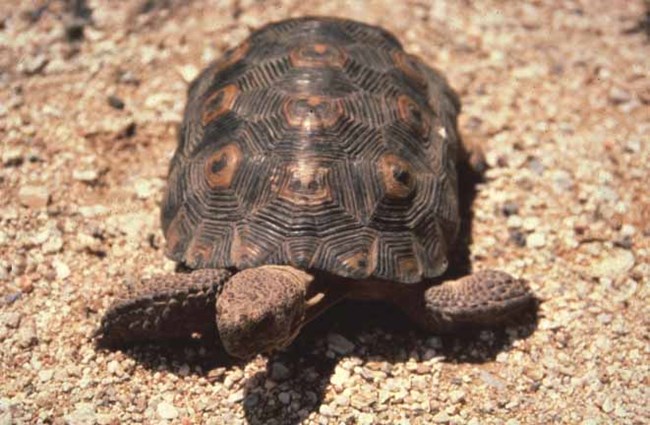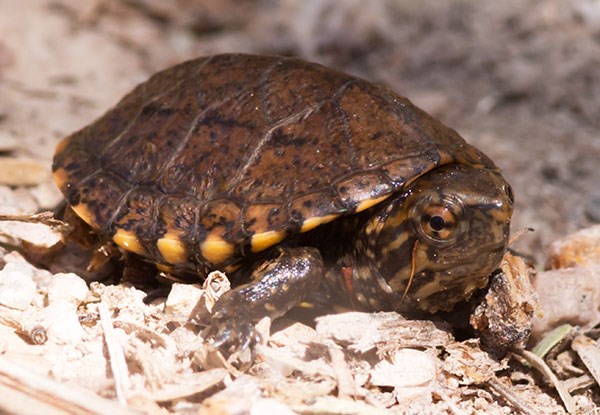
NPS photo Turtles and tortoises have evolved to carry a two-in-one home and a coat of armor with them. Their shell over their back and belly is called a “carapace” and “plastron” respectively. These hard structures are made of modified skeletal bones, providing this shelled critter’s organs support and protection from hungry predators. The shell is often capped with large scales or “scutes” that grow layer by layer and help age the turtle or tortoise. Although very similar at a glance, turtles and tortoises are adapted to different environments and are found in different places. Turtles are typically found in or near water and have more streamlined shells, while tortoises can thrive away from water and often have bumpier features. The thinner, paddle shaped feet of turtles allow for easier swimming, while stocky, scoop-shaped tortoise feet allow them to travel over land and dig holes. 
NPS photo Sonoran Desert Tortoise (Gopherus morafkai)The Sonoran Desert Tortoise is a small to medium tortoise that is well adapted to digging. This tortoise will excavate a burrow, or modify the abandoned burrow of another animal, that it may use for years. This slow-moving tortoise beats the heat by retreating into its burrow and remaining mostly inactive through the dry seasons. During the monsoon or winter rains, this tortoise will become more active, looking for water and food, and to patrol its territory. The shell, or carapace is thick and strong, providing the slow-moving tortoise protection from hungry predators. Identify this TortoiseAn adult Sonoran Desert Tortoise is roughly the size of a basketball, with a carapace about 12 inches long (30 cm). The carapace is mottled orangish brown, and the skin is gray and roughly textured. The rear legs are stout and strong, while the front legs and claws are scoop shaped to aid in digging. Look for this tortoise romping around foothills and washes where it shelters in caves and behind boulders, between snacking on leaves, branches, and fruit. 
NPS photo Sonoyta Mud Turtle (Kinosternon sonoriense longifemorale)The Sonoyta Mud Turtle only occurs naturally in the United States at Quitobaquito, at the southern end of the monument. It is a subspecies of the wider-spread Sonora mud turtle that became isolated due to the natural shifting of the Rio Sonoyta that this species originally called home. Due to climate change and human-caused environmental stress in the area, the turtles are endangered. The monument and supporters of the turtle are working hard to preserve the habitat, and won federal protection for the species in 2017. Identify this TurtleThe Sonora Mud Turtle is a small to medium sized turtle, with a shell or “carapace” reaching about 7 inches long (18 cm). The carapace is smooth with a prominent ridge or keel down the middle. The carapace and skin are brown with some yellow mottling. Younger turtles may have more prominent yellow markings. The legs are fairly slender, with wide feet used to swim. Look for these turtles swimming in the water at Quitobaquito. More About Sonoran Desert Reptiles |
Last updated: September 2, 2023
